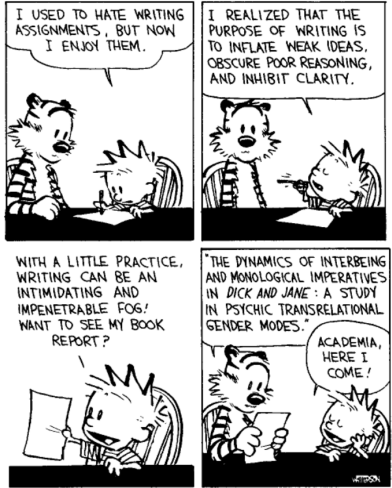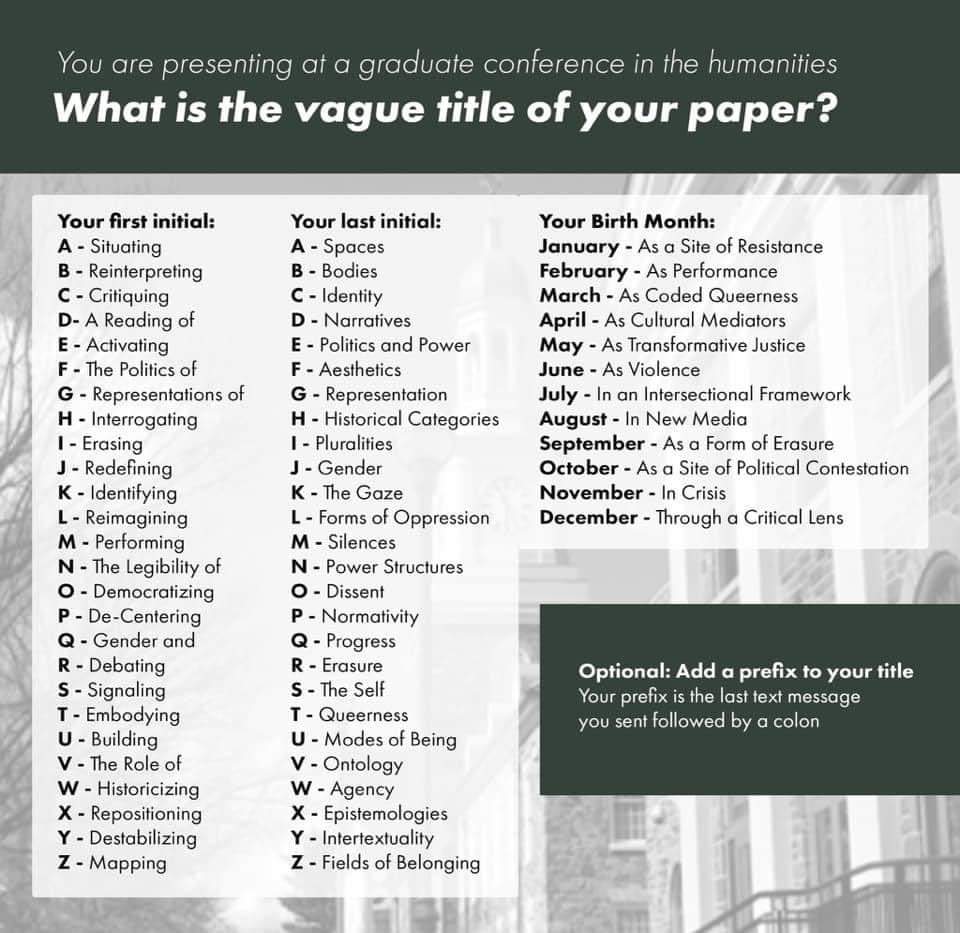
| | Writing a research paper (or a research proposal) can be compared to being a lawyer in a court case. If you were the lawyer, you would state your case (define your topic), search for evidence (find your sources), present evidence (reveal findings), and make closing arguments (discuss conclusions). Although you may believe that your client is guilty or innocent, the jury would not be interested in your opinions, but in the evidence you present and in the clear and logical manner in which you make your case. In the same way, you must objectively address your research topic as if you are the lawyer making a case for a jury. Always refer to your APA manual for the correct formatting. Look for this symbol  (the devil is in the details!) for the specific section in your APA Manual.
(the devil is in the details!) for the specific section in your APA Manual.
|  |  |
TITLE  2.3
2.3 | | |
The title of a research paper is much more important
than you may think. Many more people read research titles than
actually read the paper. The title has to do three things:- accurately describe what the paper is about
- make the reader want to read the paper
- include search terms (key words)
People often ask, "Why are the titles of research documents so LONG?? Two reasons:
- Researchers want people to read their papers! A vague title
will not catch the readers' interest and make them want to read more.
- Scholars search databases (even Google is a database!) using key
words. The more relevant words in the title make it more likely
that others will find the document in a search.
Title Page: Instead of the Professional or Student Title Page
template, please include:
- Running head
- Page number
- Paper title
- Author (your name)
- Date
|

Here are some actual title examples:
Conductor Expressivity Affects Evaluation of Rehearsal Instruction
Task-Dependent Mechanisms in the Perception of Music and Speech:
Domain-Specific Transfer Effects of Elementary School Music Education
Features of University Environments That Support Well-Being as Perceived
by Lesbian, Gay, Bisexual, and Questioning Undergraduate Music and Art
Students
Meta-Analytic Evidence of the Criterion Validity of Gordon’s Music
Aptitude Tests in Published Music Education Research
Development and Validation of a Scale Assessing Midlevel Band
Performance: A Mixed Methods Study
Effects of Focus of Attention on Performance by Second-Year Band
Students
Empowering students to take ownership of their learning: Lessons from
one piano teacher’s experiences with transformative pedagogy
Tone painting and painting tones: A follow-up study of listeners’
audiovisual responses to Beethoven’s Thunder Storm
Using Music to Encourage Joint Attention for Students with Autism
Spectrum Disorder: Attention as a Reciprocal Relationship
Supplying social capital through music education: A study on interaction
in special educational needs students’ concerts
Latent structure of gestures in orchestra conducting students under
self-observation conditions
Want to have some fun concocting your own title??

Here is my title (including my actual "last text message"):
Just Another Day at the Office: The Role of Gender as a Site of
Resistance
Sounds legit, right?
 | ABSTRACT  p. 25
p. 25 | | | Abstracts should be about 250 words long. Even though it comes first in your paper,
it should be written last. It is a concise summary of your study.
It is not an introduction to your paper. |
 | INTRODUCTION  p. 27
p. 27 | | | The introduction should present the topic of the study, questions to be answered, and the process of how the research was carried out. This section should include the RESEARCH QUESTION, THESIS STATEMENT, and the RATIONALE. One way to begin could be similar to this: (don't copy this exactly for your assignment, but this should get you started) The purpose of this ______________ (narrative, phenomenological, grounded theory, ethnographic, case, etc.) study is (was? will be?) will be to ____________ (understand, describe, develop, discover) the _____________ (central phenomenon of the study) for ______________ (the participants) at (the site). At this stage in the research, the ___________ (central phenomenon) will be generally defined as ____________ (a general definition of the central concept).
"Introduction" is not used as a heading. It is
assumed that the first part of the body of your paper is the
introduction.
|
 | DEFINITION OF TERMS | | | Any words, phrases, acronyms, etc. that will be used in your paper, specific to your research, will be defined in this section. Terms should be defined in the context of how they are used in the study. Don't define words that are common knowledge unless they are used in a
unique way in your study. |
 | LITERATURE REVIEW  p. 28
p. 28 | | | A literature review summarizes what is already known (and what is not known) about your topic. In essay form, the researcher identifies and analyzes the already published literature that is most relevant to the research project to be undertaken. A literature review is an important tool to justify a research project. It can indicate that your research has not previously been done, that you are familiar with the work that has been done and how existing scholarship supports (or contradicts) your research.
Don't get bogged down describing the details of every study that
you read. On the other hand, don't be so general that your
reader cannot tell what has already been discovered about your
topic. Don't review/summariez one article after another.
That is an annotated bibliography. Here is a chart outlining the difference between an annotated bibliography and a literature review.
The literature review should develop based upon the areas of
your topic, not a list of summarized articles. Here is a tutorial on Literature Reviews. Be sure to watch the video above. One caution: Your own thoughts about the literature will go in a concluding paragraph. Do not pepper your lit review with opinion statements. Do not make statements as facts based upon your own
experience. That is confusing to the reader who may not be sure if those opinions are yours or are from other authors in your review.
After writing, go back through and delete everything that you
did not find in the literature you reviewed.
Do not be lazy and have others supply your content by using too many
direct quotations. This is a very common rookie mistake. If you can paraphrase it/synthesize
it and maintain meaning,
do it! Remember the list of the only times to use direct quotes:
Direct Quotes
Find as much actual research as you can instead of filling your lit
review with author comments that support your own ideas (confirmation
bias). There is also a hierarchy of sources. You should use real
research as your primary documentation. Avoid opinion articles and
information that turns up on a typical Google search. Use the library
resources!
Depending on your topic, find as many research articles as you can.
Don't find a few and think "that's plenty." You need to know everything
that has been discovered about your specific topic. If the amount is
overwhelming, then your topic is not specific enough! |
 | DELIMITATIONS | | | These are the parameters that you put on your study to limit the scope. If you study is about trombone students, for example, you can't study all of them. So, you place limits on your study: only trombone players who are in the 6th grade in two middle schools in Ohio. These are not the same as 'limitations.'
Limitations are factors beyond the control of the research. Delimitations are restrictions purposely placed on the study by the researcher. Delimitations may include: | - what you are not doing (and why)
- literature you will not review (and why)
- a population you are not studying (and why)
- the procedures and methods you are not using (and why)
After you have set your delimitations, then don't think outside that box! |  |
 | METHODOLOGY  p. 29
p. 29 | | | This section should deal with two parts: where your data will come from and what will be done with the data in order to answer your research question. Methods of data collection - tests
- experiments
- surveys
- questionnaires
- observation
- interviews
- document review
This section in the research manuscript should also specify the participants of the study (descriptions of who, how selected, how many, from where, for how long). The purpose of a methodology section is to give enough detail so that
another researcher can duplicate the study. Read this article about
the Methods Section to understand the
different parts of the Methodology. Include
Participants Study Design Data Collection Data Analysis
Results (Remember that in a Research Proposal, you will not yet
have results, but you should identify what you expect to find.
See Chapter 2 in the APA Manual for more specifics! |
 | RESULTS  p. 32
p. 32 | | | Pretty self-explanatory - what you found out! After crunching the data, you will have results. Depending upon your research design, this section may include charts, graphs, or other graphic representations. If your study was quantitative in design, there will be numerical results and data. If qualitative, more discussion will be required. If you read much research, sometimes the results may seem obvious or of little use.
Here are some hypothetical comments (although I must admit I've heard every one of them, and even said a couple of them) made about a specific research finding:
Oh, I already knew that. Some things that we think we know are just assumptions. Those need to be tested. When those assumptions hold up to investigation, that piece of the puzzle can be used to build upon.
That can't be right. Perhaps one of those assumptions was tested and the results were not as expected. When that happens, the study might need to be replicated to see if those results are consistent.
That's not what I think. Systematic inquiry obligates investigators to change their views as new data are received and ideas or hypotheses tested. You may not have been the investigator, but you are a scholar and you cannot simply disregard research results. If you disagree with the findings, perhaps you could try to replicate the study to test it.
What good is that? Sometimes research studies and their results seem to lack applicability. This may be because one study is a building block for another. Many findings may lead to larger chunks of knowledge, but each step must be investigated.
|
 | DISCUSSION  p. 35
p. 35 | | | What you learned and the implications of the findings. This section also includes how your findings relate to previous research and whether these results can be applied to other populations/situations. If other research questions emerged or need for further study, that information is also included. This is not a "wrap-up" of a couple of sentences or a short
summary. |
 | REFERENCES  p. 37 p. 37 | | | Use a
Reference page at the end of the research paper. Sometimes people use this term as synonymous with 'Bibliography,' but they are not the same. A bibliography is a list of related reading on a topic, whether all sources were cited in your paper or not. 'References' include only those sources cited in your paper. |
| 
Research Proposal Here is a template to use for an
APA Research Proposal A research proposal is simply a preliminary document that answers these questions: 1. What are you planning to do? 2. Why do you want to do it? 3. How are you going to do it? |
Why write a proposal? As a plan As you prepare the proposal, your focus becomes more clear. You may have a great research question, but have no idea how to proceed . | | | To get your research funded | To convince institutions or supervisors to give you time off or resources to complete the project | | | To get your paper accepted for publication or presentation at a conference | | To demonstrate your competency in an area of study | | | | To complete a master's or doctoral program with a thesis or dissertation |
These are the main parts of a research proposal
Construct your paper as follows: | |
-
Title page (See example in APA manual p. 41)
-
Abstract (See APA manual 2.04; this is on its own page;
remember, it is written last!)
-
Introduction (See APA manual 2.05; this does not need a heading as it is assumed
that the first section of your proposal is an introduction)
-
Definition of Terms
-
Literature review
-
Delimitations and limitations
-
Methodology
-
Results
-
Discussion
-
References
| | | |
If you notice, these are basically the same as the research paper. However, you don't have findings or discussion yet because you haven't done the research! You can, however, indicate what you expect to find. Not all of the above parts have their own heading (Ex: rationale). See your APA Manual for heading styles required. You cannot just choose whether a heading is bold, italics, centered, etc. Those choices are prescribed by the format. 1. Title page Your title must give a concise indication of the nature, particularity, and scope of your research. It has to be informative and comprehensive and must honestly represent the research. Become familiar with the content and structure of good research titles by reading many of them! Go back to those databases accessed through the Tarleton library. See your APA manual for the correct form for the title page. 2. Abstract An abstract is NOT an introduction to your paper. In 200-250 words, it is simply a brief description of your entire project, including the purpose, method of research, and what conclusions you expect. The abstract is written last. 3. Introduction The introduction should include a statement of the research problem.This section expands on the research question you hope to answer in your study. It should also present a tentative answer to that question—what you hope
or expect to find. It should also include your rationale. The rationale deals with how you have arrived at the conclusion that this research should be undertaken. What was your line of reasoning? Why is it important to do this research, as a statement of logic rather than a statement of belief? This section points out the practical relevance of the problem, states what the given state of affairs is currently and what is unsatisfactory about it. 4. Definition of terms This section defines terms and concepts which are significant to your topic. It provides readers with a reference for terms that may be technical or subject to multiple meanings, thus avoiding possible misinterpretation. It defines the terms in the context where they will be used and is organized like a dictionary. If there are citations from literature for certain definitions, they should be presented in the appropriate format.
Limit to only those terms that are central to your topic and that might be misunderstood. Don't try to think up a long list.
5. Literature review This section provides a comprehensive and thorough background for the problem you are researching and puts the problem into a broader historical perspective. In the continuous narrative of the literature review, you discuss the body of research already done and currently underway, evaluating and assessing the value of the various theories, arguments, projects, and authors to your project. Leave out personal commentary, but describe studies relevant to your topic. Don't just state an opinion and cite a study that agrees with you. As a matter of fact, leave out all personal references and opinions. Use this section to objectively state and evaluate the research that
has already been done on your topic. 6. Delimitations This section not only addresses how and why your study will be narrowed in scope but also explains what you are not investigating and why you cannot or have chosen not to do so. This is the area that narrows your topic to time, place, and content. For example, your topic will not include data from all of history in
all places and from all people, but perhaps 7th graders in one
school district during one academic year. You may also be
excluding those 7th graders who move into the school district mid
year. Those details matter. 7. Methodology This section describes how information will be obtained and tested. Subsections may include Participants, Procedures, Analysis, etc. Be very specific in what you plan to do. Answer how many, where, what group, how chosen, how many times, under what conditions, etc. This should be detailed enough that someone else could do the same study.
8. Results For a proposal, you won't have results, but you can predict what you
expect to find. 9. Discussion Write a paragraph about the conclusions you hope
or expect to draw or what you hope or expect to discover. You have no findings yet, but you can discuss what significance your findings may have
and how they will benefit the field of music education. 10. References The reference list must include full reference documentation for all articles and texts mentioned in the proposal. All references should be listed alphabetically and formatted according to the APA
reference style. One of the most common mistakes in formatting is capitalizing all of the words in the reference titles. See Section 4.15 in the APA manual for correct capitalization.
A good research proposal will provide you with an excellent skeleton for your research project.

|
Created and maintained by Vicky V. Johnson 
|